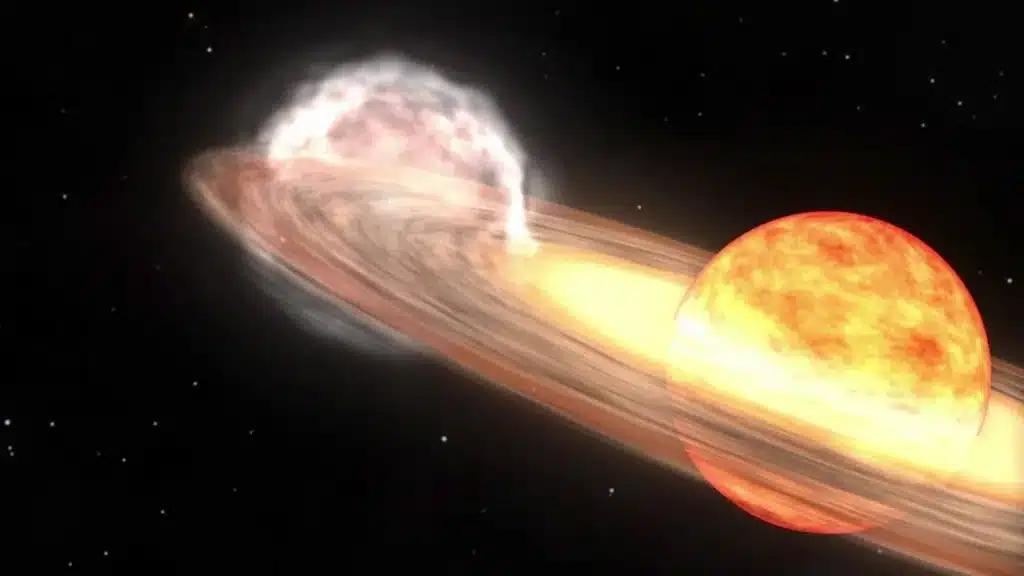
Published on June 7, 2024 07:24 By Lydia Amazouz
Collected at : https://dailygalaxy.com/2024/06/global-anticipation-rare-nova-explosion/
Astronomers around the world are eagerly awaiting a spectacular cosmic event set to occur in the constellation Corona Borealis.
This rare event involves the binary star system known as T Coronae Borealis (T CrB), or the “Blaze Star,” which is poised to undergo a nova explosion that will be visible from Earth with the naked eye.
Located approximately 3,000 light-years from Earth, T CrB’s impending eruption promises to be a once-in-a-lifetime sight, captivating both professional and amateur astronomers.
Dr. Rebekah Hounsell, an assistant research scientist specializing in nova events at NASA’s Goddard Space Flight Center, remarked, “It’s a once-in-a-lifetime event that will create a lot of new astronomers out there, giving young people a cosmic event they can observe for themselves, ask their own questions, and collect their own data.”
The Mechanics of T CrB’s Nova
T Coronae Borealis is a recurrent nova system, consisting of a white dwarf and a red giant star. The white dwarf, an Earth-sized remnant of a dead star, exerts a powerful gravitational pull on its companion, the red giant.
This gravitational force strips hydrogen from the red giant, causing it to accumulate on the white dwarf’s surface. Dr. Hounsell explains, “The hydrogen from the red giant accretes on the surface of the white dwarf, causing a buildup of pressure and heat. Eventually, it triggers a thermonuclear explosion big enough to blast away that accreted material.”
This explosion creates a bright flash visible from Earth, a phenomenon that repeats approximately every 80 years. Unlike a supernova, which destroys the star, a nova event leaves the white dwarf intact, allowing it to continue this cycle for potentially thousands of years. The cycle of accumulation and explosion is a dramatic reminder of the dynamic processes occurring in the universe.
Historical Context and Anticipation
The first recorded sighting of T CrB’s nova was in 1217, noted by Burchard, abbot of Ursberg in Germany. The last observed eruption occurred in 1946, and astronomers have noted that T CrB’s behavior in recent years mirrors the lead-up to that event.
Mark Hollands, a Research Fellow at the University of Warwick, points out, “Observations of T CrB in the months leading up to the 1946 eruption revealed a pronounced drop in brightness, indicating the explosion was imminent.”
Similar dimming has been observed earlier this year, signaling that the next nova could occur by September 2024. The anticipation is heightened by the historical regularity of T CrB’s eruptions, which adds to the excitement of witnessing such a rare and predictable cosmic event. This consistency over centuries makes T CrB a fascinating subject of study for understanding stellar behaviors and cycles.
Observing the Nova Explosion
For those eager to witness this celestial event, the Northern Crown (Corona Borealis) is the key area to watch. This constellation is a horseshoe-shaped arc of stars located west of the Hercules constellation.

It can be found by drawing a line between the two bright stars Arcturus and Vega. Dr. Elizabeth Hays, chief of the Astroparticle Physics Laboratory at NASA Goddard, encourages stargazers, “The outburst will be brief. Once it erupts, it will be visible to the naked eye for a little less than a week – but it will be quite a sight to see.”
Stargazers are advised to familiarize themselves with the night sky in advance, as this will enhance their experience when the nova becomes visible. Using tools such as smartphone apps for stargazing can help locate the constellation accurately. Dr. Hays adds, “Seeing the nova will be a spectacular event, creating a sudden and noticeable change in the familiar pattern of stars.”
Scientific Collaboration and Data Collection
NASA’s preparation for this event includes a robust collaboration between various space-based and ground-based observatories. The Fermi Gamma-ray Space Telescope, James Webb Space Telescope, and other instruments like IXPE, NuSTAR, and NICER will observe the nova across different wavelengths. Ground-based facilities, including the Very Large Array in New Mexico, will complement these observations. Dr. Hounsell notes, “We’ll observe the nova event at its peak and through its decline, as the visible energy of the outburst fades. But it’s equally critical to obtain data during the early rise to eruption.”
This event highlights the importance of citizen scientists. Enthusiastic amateur astronomers play a crucial role in early detection and continuous monitoring. Their contributions help trigger more focused observations by professional astronomers, ensuring no phase of the nova goes undocumented. This collaborative effort between professionals and amateurs underscores the inclusive nature of astronomical research, where data from various sources enhance the overall understanding of stellar phenomena.
The Role of Advanced Instruments
This event will also utilize new instruments that were not available during previous eruptions. Gamma-ray imagers and X-ray polarimetry tools, such as those on the IXPE mission, will provide unprecedented insights into the nova’s characteristics. “Combining their data could offer unprecedented insight into the lifecycles of binary systems and the waning but powerful stellar processes that fuel them,” says Dr. Hays.
The ability to observe in different wavelengths, from gamma rays to radio waves, allows scientists to piece together a comprehensive picture of the event. These advanced tools will help identify the structure and dynamics of the nova explosion, offering clues about the processes at work in similar stellar systems throughout the universe. The integration of data from multiple observatories and instruments will enable a detailed analysis of the nova, advancing our understanding of these dramatic stellar events.

Leave a Reply